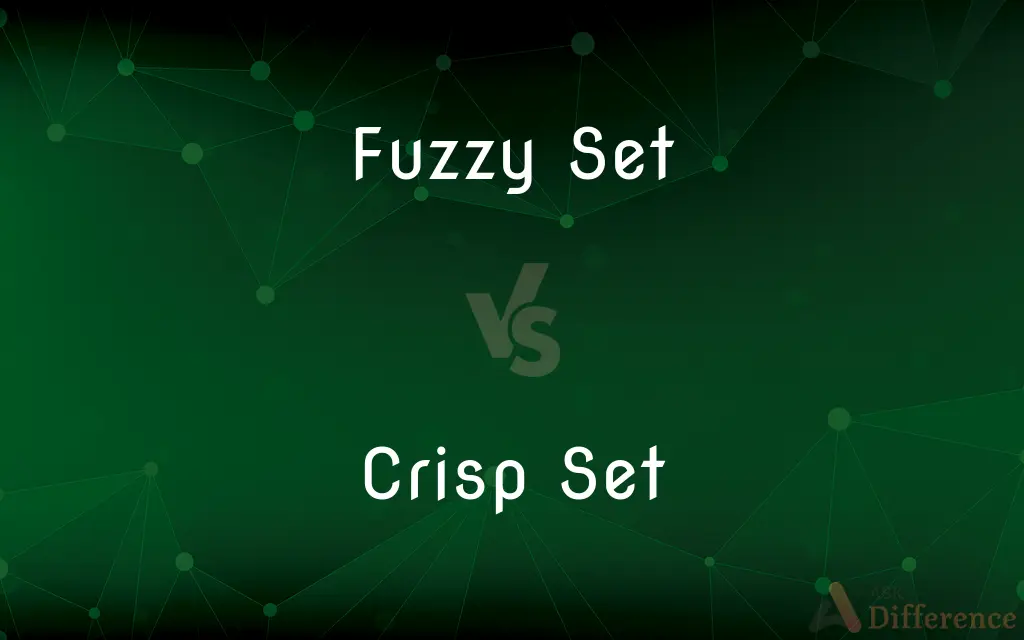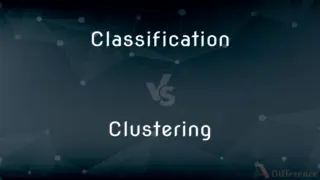Fuzzy Set vs. Crisp Set — What's the Difference?
By Tayyaba Rehman — Published on January 4, 2024
Fuzzy Set allows partial membership, representing uncertainty and gradations in data. Crisp Set has clear boundaries, with elements either fully in or out of the set.

Difference Between Fuzzy Set and Crisp Set
Table of Contents
ADVERTISEMENT
Key Differences
Fuzzy sets, a concept introduced by Lotfi Zadeh in the 1960s, allow for degrees of membership, meaning elements can partially belong to a set. This is particularly useful in dealing with real-world scenarios where information is uncertain or vague. For example, a set of "tall people" can have varying degrees of tallness. In contrast, crisp sets, also known as classical sets, have well-defined, clear boundaries. An element either belongs to a set or it doesn't, with no intermediate state. For instance, in a crisp set of prime numbers, a number is either prime or not, with no degree of primeness.
In fuzzy sets, membership is expressed with a value ranging between 0 and 1, indicating the degree to which an element belongs to a set. This gradation allows fuzzy sets to handle ambiguous or imprecise information effectively. Crisp sets, however, only use binary membership values: 0 or 1, indicating non-membership or full membership, respectively. This clear-cut approach suits scenarios with definite and precise criteria.
The concept of fuzzy sets is widely applied in fields like artificial intelligence, control systems, and decision-making, where ambiguity and subjective interpretations are common. They allow for more nuanced and flexible reasoning compared to crisp sets. Crisp sets are more prevalent in classical mathematics and computer science applications where precise definitions and distinct categories are essential.
From a computational perspective, fuzzy set operations (like union, intersection, and complement) are defined based on the degrees of membership, leading to results that accommodate uncertainty. In crisp sets, these operations are straightforward, adhering to strict logical definitions and producing unambiguous results.
In summary, fuzzy sets provide a framework for dealing with uncertainty and vagueness in various real-world applications, while crisp sets are suited for situations that require clear, binary decisions and classifications. The choice between using a fuzzy set or a crisp set depends on the nature of the problem and the required precision in handling data and information.
ADVERTISEMENT
Comparison Chart
Membership
Partial, with a range between 0 and 1.
Binary, either 0 (non-member) or 1 (member).
Application
Suited for ambiguous or uncertain data.
Used for precise, clear-cut data.
Fields
Common in AI, control systems, decision-making.
Prevalent in classical mathematics and computer science.
Operations
Based on degrees of membership, allowing for uncertainty.
Strict logical operations with definite results.
Suitability
Effective in handling subjective or nuanced scenarios.
Ideal for scenarios requiring definitive categorization.
Compare with Definitions
Fuzzy Set
A fuzzy set allows elements to have partial membership.
In a fuzzy set, the age '20' might have a 0.7 degree of belonging to 'young'.
Crisp Set
Membership in a crisp set is strictly binary: 0 or 1.
In a crisp set of 'sunny days', a day is either sunny (1) or not sunny (0).
Fuzzy Set
Fuzzy sets are ideal for dealing with vagueness and ambiguity.
The concept of 'comfortably crowded' in a restaurant was modeled using a fuzzy set.
Crisp Set
Crisp sets follow classical logic in their operations.
The union of crisp sets 'multiples of 2' and 'multiples of 3' yields a clear set of numbers.
Fuzzy Set
Operations in fuzzy sets handle degrees of truth.
The intersection of fuzzy sets 'tall' and 'athletic' created a nuanced athlete profile.
Crisp Set
Elements in a crisp set are either fully in or out.
The crisp set of 'red objects' includes a red apple but excludes a green apple.
Fuzzy Set
Membership degrees in a fuzzy set range between 0 and 1.
The temperature 'warm' in a fuzzy set could be assigned a membership of 0.6.
Crisp Set
Crisp sets are used for precise, unambiguous categorization.
The set of prime numbers less than '10' is a crisp set with definite members.
Fuzzy Set
Fuzzy sets are commonly used in artificial intelligence.
Fuzzy logic was used in an AI system to assess creditworthiness with varying degrees.
Crisp Set
A crisp set has clear, binary membership for its elements.
In a crisp set of even numbers, '4' is a member while '5' is not.
Common Curiosities
Where are Fuzzy Sets commonly used?
In fields dealing with uncertainty and subjectivity, like AI and control systems.
How do Fuzzy Sets represent uncertainty?
By allowing elements to have partial membership degrees, reflecting uncertainty.
What kind of logic do Fuzzy Sets use?
Fuzzy sets use fuzzy logic, which deals with degrees of truth.
How do operations differ between Fuzzy and Crisp Sets?
Fuzzy set operations consider partial memberships, while crisp set operations follow classical binary logic.
Can elements partially belong to a Crisp Set?
No, elements in a crisp set are either completely in or out.
What is a Fuzzy Set?
A fuzzy set allows elements to have varying degrees of membership between 0 and 1.
What is a Crisp Set?
A crisp set is one where each element has a clear, binary membership status.
Are Crisp Sets suitable for subjective data?
No, they are better suited for objective, clear-cut data.
Can Fuzzy Sets handle ambiguous scenarios?
Yes, they are particularly effective in handling ambiguity.
Are Fuzzy Sets more complex than Crisp Sets?
Typically, yes, due to the handling of gradations in membership.
Can a Crisp Set be converted to a Fuzzy Set?
Conceptually, yes, by introducing degrees of membership.
Is the membership in a Fuzzy Set quantifiable?
Yes, with values between 0 and 1 indicating the degree of membership.
Do Fuzzy Sets require more computational resources than Crisp Sets?
Generally, yes, as they deal with more complex calculations involving partial memberships.
Do Crisp Sets provide definite answers?
Yes, crisp sets yield definitive, unambiguous categorization.
Are Crisp Sets used in traditional mathematics?
Yes, they are prevalent in conventional mathematical and computational applications.
Share Your Discovery

Previous Comparison
Nouns vs. Verbs
Next Comparison
Classification vs. ClusteringAuthor Spotlight
Written by
Tayyaba RehmanTayyaba Rehman is a distinguished writer, currently serving as a primary contributor to askdifference.com. As a researcher in semantics and etymology, Tayyaba's passion for the complexity of languages and their distinctions has found a perfect home on the platform. Tayyaba delves into the intricacies of language, distinguishing between commonly confused words and phrases, thereby providing clarity for readers worldwide.
















































